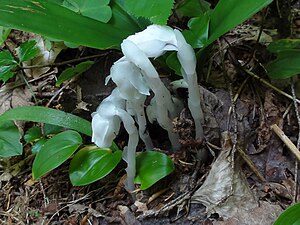Note: This is a project under development. The articles on this wiki are just being initiated and broadly incomplete. You can Help creating new pages.
Monotropa uniflora
Monotropa uniflora is also known as ghost plant. It is an herbaceous perennial plant native to temperate regions of Asia, North America and northern South America, but with large gaps between areas. The plant is sometimes completely waxy white, but often has black flecks or pale pink coloration. Rare variants may have a deep red color.
Uses
Parts Used
Chemical Composition
Stamens 10, sometimes 8; anthers short on the thickened apex of the hairy filament, 2-celled, opening by transverse chinks.[1]
Common names
| Language | Common name |
|---|---|
| Kannada | |
| Hindi | |
| Malayalam | |
| Tamil | |
| Telugu | |
| Marathi | NA |
| Gujarathi | NA |
| Punjabi | NA |
| Kashmiri | NA |
| Sanskrit | |
| English | Indian Pipe, Ghost Flower |
Properties
Reference: Dravya - Substance, Rasa - Taste, Guna - Qualities, Veerya - Potency, Vipaka - Post-digesion effect, Karma - Pharmacological activity, Prabhava - Therepeutics.
Dravya
Rasa
Guna
Veerya
Vipaka
Karma
Prabhava
Habit
Identification
Leaf
| Kind | Shape | Feature |
|---|---|---|
| Simple | Variable | The stems reach heights of 10-30 cm, clothed with small scale-leaves 5-10 mm long. As its species name monoflora suggests, the stems bear only a single flower, 10-15 mm long with 3-8 petals. |
Other features
List of Ayurvedic medicine in which the herb is used
Where to get the saplings
Mode of Propagation
How to plant/cultivate
It is likely to require shady woodland conditions in a humus-rich moist soil, It is a saprophytic plant, quite devoid of chlorophyll and depending totally on its host plant for nutrient.[3]



